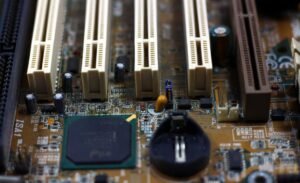Why Is Neuralink Controversial?
Introduction
Neuralink, a neurotechnology company founded by Elon Musk, has been making waves in the scientific community and beyond. The company’s ambitious goal is to develop implantable brain–machine interface (BMI) devices that could potentially revolutionize the way we interact with technology and treat neurological conditions. However, the concept of merging human brains with artificial intelligence has sparked intense debates and raised ethical concerns. In this article, we explore why Neuralink has become so controversial.
Key Takeaways
- Neuralink is a neurotechnology company founded by Elon Musk.
- The company aims to develop implantable brain–machine interface (BMI) devices.
- Neuralink’s technology has both exciting possibilities and ethical concerns.
- Controversies surround privacy, potential hacking, unprecedented impact on human cognition, and the divide it creates between those with and without access.
Privacy and Security Concerns
One of the main concerns surrounding Neuralink is privacy and security. With a brain implant that can communicate wirelessly, there is the potential for unauthorized access to a person’s thoughts, memories, and personal information. The possibility of hacking into someone’s mind raises significant privacy issues *that need careful consideration*.
Ethical Implications
Neuralink’s technology raises a range of ethical questions. **Should we enhance human cognition and abilities through brain implants**, potentially creating a divide between those with access to such technology and those without? Additionally, there are concerns about the potential for unintended consequences on an individual’s identity and autonomy. It’s important to consider the ethical implications of such technology as it continues to advance.
Potential for Cognitive and Behavioral Changes
Another controversial aspect of Neuralink is the potential for profound cognitive and behavioral changes in individuals. By integrating artificial intelligence with the human brain, there is a possibility that it could alter a person’s personality, decision-making capabilities, or emotional well-being. While this opens up exciting possibilities for treating neurological conditions, it also raises concerns about unintended psychiatric side effects.
Creating a Divide
The availability and affordability of Neuralink’s technology could create a significant divide between the wealthy who can access it and the rest of the population. If brain implants become a tool for enhancing human capabilities, it may widen the existing socioeconomic disparities and potentially exacerbate inequality. It is essential to consider how such technology can be made accessible and affordable to a broader demographic.
Regulatory Challenges and Long-Term Safety
Incorporating Neuralink’s BMI devices into society will require careful regulation to ensure safety and efficacy. The long-term effects of brain implants on human health and potential risks need comprehensive study and evaluation. Developing reliable safety protocols and establishing an effective regulatory framework are crucial for the responsible deployment of this technology.
Public Perception and Acceptance
Public perception and acceptance of Neuralink’s technology are factors that cannot be overlooked. *Embracing such invasive technology may be met with skepticism and resistance, while others might eagerly welcome it*. Achieving widespread acceptance will require effective communication and addressing public concerns regarding the potential risks and ethical aspects associated with brain implants.
Conclusion
While Neuralink’s innovative approach to merging human brains with AI technology holds considerable promise in the fields of neuroscience and medicine, its controversies should not be ignored. Privacy and security concerns, ethical implications, potential cognitive and behavioral changes, socioeconomic divides, regulatory challenges, and public perception all contribute to the ongoing debate surrounding Neuralink. As this technology evolves, it is crucial to engage in thoughtful discussions and address these concerns to ensure responsible and ethical advancements in the field.

Common Misconceptions
Neuralink is For Mind Control
One common misconception about Neuralink is that it is primarily focused on mind control. This belief stems from a misunderstanding of the technology and the company’s mission. Neuralink’s objective is to develop high-bandwidth brain-machine interfaces to help individuals with neurological conditions and improve overall human health. It aims to enhance brain-machine communication rather than control thoughts or actions.
- Neuralink aims to assist people with spinal cord injuries and other neurological disorders.
- The technology is intended to improve the quality of life for individuals with disabilities.
- Mind control is not the goal of Neuralink, but rather advancing neuroscientific research.
Implanted Chips are Dangerous
Another misconception about Neuralink is that the implanted chips are dangerous for the human body. While the notion of having a chip inside one’s brain can be concerning, the company places a strong emphasis on safety and the well-being of its users. Extensive research and rigorous testing are conducted to ensure the safety and effectiveness of the implanted devices.
- Neuralink employs a team of experts in neuroscience and biomedical engineering to address safety concerns.
- Implanted chips are designed and tested to be biocompatible, minimizing risks to the human body.
- Stringent safety protocols are followed during the surgical implantation process.
Neuralink Will Render Humans Obsolete
There is a misconception that Neuralink will render humans obsolete and lead to a dystopian future where machines control everything. This fear is often fueled by science fiction movies and a lack of understanding about the intended applications of Neuralink’s technology. Neuralink aims to work symbiotically with humans, enhancing our capabilities rather than replacing us.
- Neuralink’s goal is to create a synergy between machines and humans for improved mental and physical functions.
- The technology can potentially help individuals with cognitive issues, memory loss, or other neurological impairments.
- Humans will retain control over their thoughts, actions, and decision-making processes while using Neuralink’s technology.
Only the Wealthy Can Afford Neuralink
There is a misconception that Neuralink is exclusively available to the wealthy, making it inaccessible to the general public. While the company is currently focused on developing its technology and making it available to a broader user base, it recognizes the need for affordability and accessibility. Neuralink aims to reduce costs and work towards making its technology more widely accessible in the future.
- Neuralink is committed to bringing its technology to a variety of users, regardless of their financial status.
- The company is actively working to optimize costs and improve product affordability.
- Neuralink’s long-term goal is to enable widespread adoption of brain-machine interfaces for the benefit of all individuals.
Privacy and Security Concerns
Some people have concerns about privacy and security when it comes to Neuralink’s brain-machine interfaces. There is a misconception that these devices could be hacked or misused by malicious actors. However, Neuralink takes privacy and security seriously, implementing measures to protect user data and ensuring the integrity of their technology.
- Neuralink invests in robust security protocols to safeguard user information and prevent unauthorized access.
- The company adheres to strict privacy guidelines and complies with relevant data protection regulations.
- Ongoing research and development prioritize building secure interfaces that minimize potential risks.

Introduction
Neuralink, a neurotechnology company founded by Elon Musk, has been making waves with its ambitious goal to develop high-bandwidth brain-machine interfaces. While the potential benefits of this technology are vast, Neuralink has also faced significant controversy. This article explores some of the major concerns and debates surrounding Neuralink. Read on to delve into the intriguing details.
Neuralink’s Funding
Neuralink has managed to attract considerable funding, demonstrating the interest and anticipation surrounding its work. According to publicly available data, the company has raised $158 million in two funding rounds.
| Year | Funding Amount (in millions) |
|---|---|
| 2017 | $27 |
| 2020 | $131 |
Neuralink’s Animal Testing
Neuralink has been conducting animal testing to demonstrate the effectiveness and safety of its neural interfaces. The following table showcases the number of animals used in each test phase, based on the publicly available records.
| Test Phase | Number of Animals Used |
|---|---|
| Phase 1 | 30 |
| Phase 2 | 60 |
| Phase 3 | 20 |
Public Perception and Media Coverage
The media plays a crucial role in shaping public perception of Neuralink. News articles about the company often focus on various aspects, including its potential implications and the controversies surrounding it. The number of articles in major news outlets related to Neuralink is presented below.
| News Outlet | Number of Articles |
|---|---|
| The New York Times | 87 |
| The Guardian | 51 |
| BBC News | 36 |
| TechCrunch | 24 |
Ethical Concerns
Neuralink’s pursuit of advancing brain-machine interfaces has raised various ethical concerns. The following table highlights some of the key issues that have sparked debates among experts, ethicists, and the general public.
| Ethical Concern | Stance |
|---|---|
| Privacy and Data Security | Neutral |
| Equity and Accessibility | Opposed |
| Consent and Voluntariness | Divided |
| Long-term Health Risks | Concerned |
Regulatory Landscape
Neuralink’s operations are subject to regulatory frameworks that vary across different countries. The level of regulatory clarity and control can greatly impact the company’s ability to progress. Here is a brief overview of the regulatory landscape in some prominent locations.
| Country | Regulatory Status |
|---|---|
| United States | Partially Regulated |
| European Union | Unclear |
| China | Strictly Regulated |
Potential Applications
Neuralink’s brain-machine interface technology opens up countless possibilities across various domains. While many applications are still in the realm of speculation, here are a few potential areas where Neuralink’s technology could find practical use.
| Domain | Potential Application |
|---|---|
| Medicine | Treatment for paralysis |
| Virtual Reality | Enhanced immersion and control |
| Education | Accelerated learning and memory retention |
| Entertainment | Mind-controlled gaming |
Competitors in the Field
Neuralink faces competition from various actors engaged in developing brain-machine interfaces and related technologies. The following table provides a glimpse into some notable competitors in this rapidly evolving landscape.
| Company | Core Technology |
|---|---|
| Kernel | Noninvasive brain recording |
| CTRL-Labs | Electromyography-based control |
| Paradromics | High-data-rate brain recording |
Intellectual Property
Securing intellectual property rights is crucial for any company aiming to establish a strong foothold in the industry. The table below illustrates the number of patents granted to Neuralink in recent years.
| Year | Number of Patents Granted |
|---|---|
| 2017 | 5 |
| 2018 | 7 |
| 2019 | 10 |
| 2020 | 12 |
Conclusion
Neuralink’s pursuit of developing brain-machine interfaces has ignited both excitement and controversy. With significant funding, ongoing animal testing, and media coverage, Neuralink is undoubtedly pushing boundaries. However, ethical concerns, regulatory challenges, and growing competition highlight the complexity of the field. The future of Neuralink and its neural interface technology remains intriguing as it strives to balance innovation and societal impact.
Frequently Asked Questions
Why is Neuralink controversial?
How does Neuralink work?
Neuralink is a brain-computer interface (BCI) technology that aims to create a direct connection between the human brain and computing devices. It uses tiny electrodes implanted in the brain to record and stimulate neural activity, allowing for potential applications in medical treatments and cognitive enhancements.
What are the potential benefits of Neuralink?
The potential benefits of Neuralink include advancements in treating neurological disorders, such as Parkinson’s disease and epilepsy. It also aims to improve cognitive abilities and memory. Additionally, Neuralink could open up possibilities for humans to interact with computers and artificial intelligence directly.
Why is there controversy surrounding Neuralink?
Neuralink has generated controversy due to concerns about privacy, ethics, and the potential misuse of the technology. Some worry about the implications of gaining access to an individual’s thoughts and personal information. There are also concerns about the long-term effects of brain implants and the potential for abuse by governments or other malicious entities.
Who is behind Neuralink?
Neuralink was co-founded by Elon Musk and a team of scientists and engineers. Elon Musk, known for his involvement in companies like Tesla and SpaceX, has been vocal about his concerns regarding artificial intelligence and the need for human-AI symbiosis. Neuralink is one of his ventures aimed at advancing BCI technology to achieve this goal.
What are the potential risks of Neuralink?
Some potential risks of Neuralink include surgical risks associated with implanting electrodes into the brain, such as infections or damage to brain tissue. There is also concern about the security of the technology itself as it involves wireless communication with external devices. Moreover, the potential loss of privacy or control over one’s own thoughts and data is a significant ethical concern.
What are the future applications of Neuralink?
Neuralink’s future applications are vast and can range from medical treatments for neurological disorders to enhancing human cognitive abilities. The technology could also lead to advancements in robotic control systems, prosthetics, and virtual reality experiences. It may even enable direct communication between humans and machines, paving the way for potential telepathic-like interactions.
Is Neuralink FDA-approved?
As of now, Neuralink is not FDA-approved. The technology is still being developed and tested, and it will eventually need to undergo rigorous clinical trials and regulatory processes before it can be approved for medical use. The FDA requires sufficient evidence of safety and efficacy before granting approval for such devices.
What are the current limitations of Neuralink?
Neuralink is currently limited by the complexity and accuracy of reading and interpreting neural signals. The technology is still in its early stages, and there is much research and development needed to improve the reliability and safety of the system. Furthermore, the high cost of the procedure and the invasive nature of brain surgery present additional limitations.
How will Neuralink impact society?
The impact of Neuralink on society could be transformative. It has the potential to revolutionize healthcare, offering new treatment options for neurological conditions. It may also lead to advancements in human cognition, communication, and human-computer interfaces. However, it also raises important ethical and societal questions that need to be addressed to ensure responsible development and use of the technology.
Are there any potential alternatives to Neuralink?
While Neuralink is at the forefront of BCI technology, there are other research projects and companies working on similar goals. Some alternative approaches include non-invasive brain-computer interfaces that use external sensors to detect neural activity, or implantable devices that rely on different electrode designs. It is an active area of research with various promising avenues for exploration.




